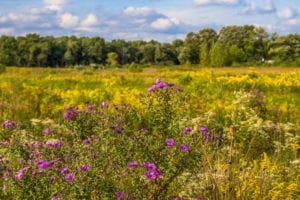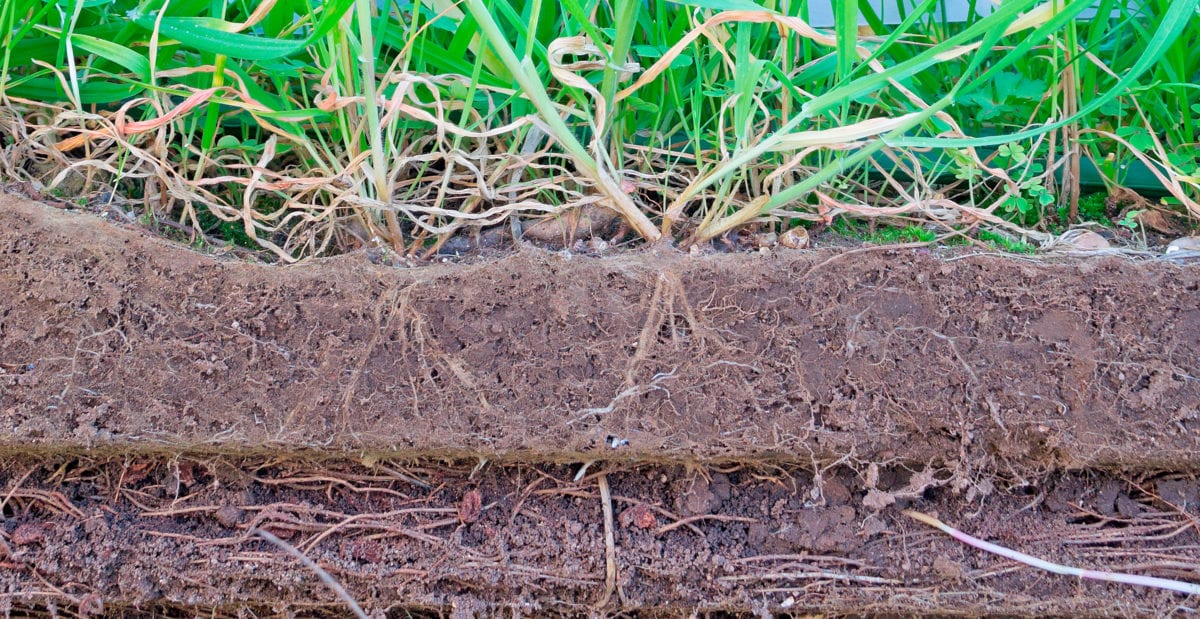Prairies are designed to optimize all the resources that nature gives. They use diversity to create mutually beneficial relationships that exchange of nutrients to support life in the ecosystem.
A prairie ecosystem supports long-term sustainability and resilience. Its design is built on perennial plants, nutrient exchange, and diverse root systems. The diversity of plant life causes the prairie to have both surface and deep root systems which enable it to capture and use all the rainfall it receives.
One way a prairie optimizes nature’s resources is the way it absorbs rain. Today, we are having more large quantity rain events where 4-6 inches or more fall at a time. When a lot of rain falls on a prairie, the surface root system absorbs the rainfall first. After they become saturated, the deep root systems pull the moisture into the soil of the prairie. This allows the surface roots to absorb more rain.
This dynamic continues and between the root system and the richness of the soil, it captures all the rainfall and eliminates run-off. This is different from what happens in a field planted with a single crop. A field filled with corn or soybeans only have surface root systems. When a lot of rain falls, the soil initially absorbs the rain, but once it is saturated, the rain runs off the field. Not only does it stop absorbing rainfall, but the continued rain packs down the soil, which makes it difficult to absorb the next rainfall.
Information as Organizational Rainfall
Organizations have their version of deluges, like a 4-10 inch rainfall. For example, information often comes in a quantity that makes it hard for an organization to absorb it. It is like we are designed like a monoculture field; filled with surface roots, but can’t absorb all the information that would benefit the organization.
Peter Senge once said that we rarely can capture all the information in people’s heads to make good decisions. He made his point by drawing a funnel. At the top of the funnel, there were one billion data points that individuals knew in the organization. Of that one billion, the organization only captures one million data points that become shared information with the organization. Of that one million data points, only 100,000 of the original 1 billion are used to make organizational decisions.
The data and information that is held in our heads are similar to a major rainfall event and the organization can only absorb .0001 percent of what is present. That is a huge loss of a knowledge resource that exists within an organization. This may explain why people in the organization sometimes view organizational decisions with skepticism because the decision doesn’t reflect the data and understanding they have in their head.
This example focuses on the importance of organizational learning, which Peter Senge initially shared in his book The Fifth Discipline (1990). But there are other sources of data that come from outside the organization. If – like a monocrop – we can only absorb .0001 % of the outside information that is falling on the organization, we are seriously hampered in our understanding of what we need to adapt.
What Can Deep Root Systems Teach Us About Absorbing Information?
How can an organization absorb more information that is coming to it from the external environment? How can organizations capture and harvest more knowledge that already exists in the organization?
The prairie would tell us that diversity and design are two ways to create better absorption. For a prairie, the diversity of plant life creates root systems that develop at different levels in the soil. Organizationally, can we imagine individuals who can harvest and integrate information into knowledge? What if our organizations intentionally identified who in their organization had the capacity to do this and supported this ability?
By encouraging and rewarding this talent, the organization could develop a deep root system of people who could process information, relationships, connections, and meaning. These people can help the organization see what is going on in the external environment and identify the resources in its own organization.
One of the essential facets of leadership is helping to make meaning of events and dynamics. This helps others have a deeper understanding of what is occurring. Widely distributed leadership is an example of a deep organizational root system.
Dr. Kathleen E. Allen writes a blog on leadership and organizations that describes a new paradigm of leadership that is based on lessons from nature and living systems. She is the author of Leading from the Roots: Nature Inspired Leadership Lessons for Today’s World (2018) and President of Allen and Associates, a consulting firm that specializes in leadership, innovation, and organizational change. You can sign up for her blog on her website: www.kathleenallen.net








